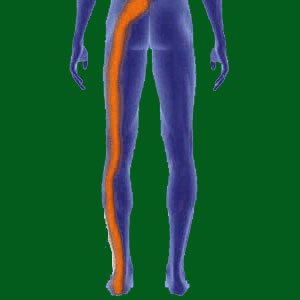
Spondylolisthesis sciatica is a very common symptom set caused by severe, high grade listhesis that compresses the spinal nerve roots due to central or foraminal vertebral canal misalignment. Sciatica is one of the most prevalent and feared of all dorsalgia diagnoses, mostly due to its chronic, treatment-defiant nature and its almost endless diversity of possible symptomatic expressions in the lower anatomy.
Sciatica is a very misunderstood problem, since it is not a diagnosis unto itself, but merely an expression of specific symptoms that can be caused by a myriad of potential causes. Spondylolisthesis is just one of many possible explanations for sciatica and often exists in combination with other potentially explanative factors, making diagnostic verdicts suspect in so many patient profiles.
This investigative article delves into the mechanisms through which listhesis can cause sciatica. We will examine central and foraminal versions of sciatica, as well as pseudo-sciatica issues that are still directly linked to listhesis expressions.
Central Canal Spondylolisthesis Sciatica
Compression of the cauda equina nerve roots often occurs as a massed grouping in the central canal. Spondylolisthesis can misalign the central vertebral canal space, creating pressure on these nerve roots. With the addition of other common degenerative conditions in the lumbar spine, such as disc desiccation, intervertebral herniation and osteoarthritis also reducing the patency of the central canal, it is common for listhesis to create a condition of central spinal stenosis.
When any of the lumbar roots including L4, L5, S1, S2 and S3 are compressed, sciatica symptoms might result. Sciatica expressions from central stenosis can be wide-ranging, affecting most of the buttocks, legs and feet. If many of the roots are compressed together, the condition is known as cauda equina syndrome and includes terrible expressions including the inability to stand, saddle paresthesia, sexual dysfunction and loss of normal bowel and bladder functionality.
Neuroforaminal Canal Sciatica
Less serious than central spinal stenosis, neural foraminal stenosis can also result at one or more levels when listhesis misaligns the openings of the foramen through which the nerve roots exit the spine to create the sciatic nerve. Once again, if one or more of the nerve roots L4, L5 or S1 are compressed when exiting the spine, sciatica might result.
In cases of single or double nerve root compression, symptoms should correlate to specific locations on the lower body. Remember that each anatomical area is innervated by particular nerve roots, so symptoms should correlate by location to the specific roots that are theorized to be compressed. Neurological evaluation can confirm these suspicions.
As noted above, additional degenerative factors often combine with listhesis to block the foraminal openings. These factors include osteophyte growth on and around the facet joints, arthritic accumulation within the foraminal spaces, decrease in foraminal patency from disc desiccation and partial obstruction of the openings from posterolateral, foraminal and far lateral herniated discs.
Spondylolisthesis Sciatica and Pseudo-Sciatica
Besides directly causing sciatica from spinal nerve root compression in the lower back, listhesis can also contribute to its formation due to other factors, as detailed below:
Listhesis often changes posture and gait. These anatomical and functional alternations can have consequences on structures in the regional anatomy of the spine, pelvis and hip. Commonly, significant changes to posture and ambulation will influence the piriformis muscle and sacroiliac joint. The piriformis muscle can compress the fully formed sciatic nerve, causing pseudo-sciatica throughout the lower body. Meanwhile, the sacroiliac ligaments can also influence the sciatic nerve, potentially eliciting symptoms, as well.
Although not technically sciatica or pseudo-sciatica, these same changes to posture and gait can produce lower limb pain in the feet, ankles, knees and/or hips due to functional concerns. When symptoms exist in several of these areas at once, the expressions are sometimes mistaken for true spinally-motivated sciatica or pseudo-sciatica.
Sciatica remains a primary focus of all of our websites in The Cure Back Pain Network. We explore the topic in great detail throughout most of our web properties and even provide a free dedicated resource that covers the subject in the deepest detail imaginable. Sciatica-Pain.Org is the definitive web property covering everything relating to sciatica.
Spondylolisthesis > Spondylolisthesis Symptoms > Spondylolisthesis Sciatica



